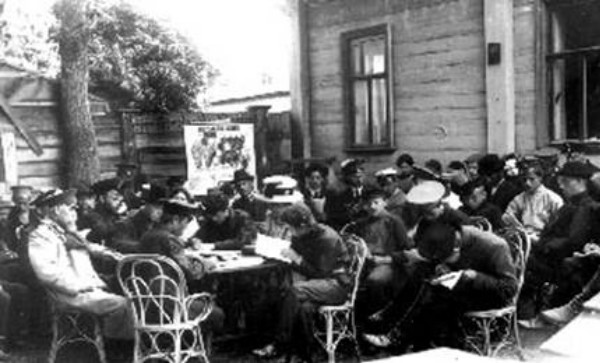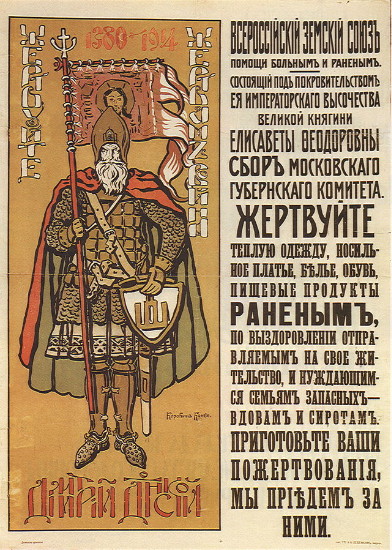Zemstvo
Zemstvo [Земство]. A gubernia and county institution for municipal self-government that existed in most European gubernias of the Russian Empire from 1865 until the Bolshevik Revolution of 1917. Under pressure from liberal nobles and the intelligentsia, Tsar Alexander II confirmed the Zemstvo Statute on 1 January 1864. Electoral institutions, specifically gubernia and county zemstvo assemblies (decision-making bodies) and zemstvo boards (executive bodies) were introduced in 1865. The jurisdiction of the zemstvos included municipal, economic, social, and educational affairs. They were to manage property, build and maintain roads, undertake measures for the improvement of agriculture, trade, and industry, and oversee medical services, sanitation, public education, veterinary medicine services, insurance, fire prevention, and other activities. The work was financed by special taxes on agricultural land, commercial and industrial properties, and business and guild licenses, as well as direct government subsidies (the latter initially constituted only a small portion of revenues, but increased substantially after 1905). Provincial zemstvo organizations were established in 1865 in Chernihiv gubernia, Kharkiv gubernia, Kherson gubernia, and Poltava gubernia and in 1866 in Katerynoslav gubernia and Tavriia gubernia. They were not introduced in Right-Bank Ukraine (Kyiv gubernia, Volhynia gubernia, and Podilia gubernia) until 1911 because of official concerns about extending local institutions of self-government into areas where a large portion of the nobility was Polish (particularly after the Polish Insurrection of 1863–4).
The zemstvo consisted of a mix of appointed and elected delegates. Separate electoral bodies existed for three classes of delegates, landowners, merchants and industrialists, and peasants. Those provisions were modified in 1890 in a revised Zemstvo Statute, which limited landowner representation to the nobility and turned over the selection of peasant representatives to the provincial governor. Orthodox clergy and Jews were also forbidden to hold zemstvo offices at that time. All zemstvo positions had a three-year term, and the zemstvo assemblies usually sat once a year. In spite of provisions for representation from various estates, the zemstvo structure was dominated by the gentry both in absolute numbers and in leadership positions. As a rule the delegates from the nobility had more than half the votes in county zemstvo assemblies. They tended to have an even greater representation on the county executive boards and in the gubernia zemstvo organizations. In 1903 the county zemstvo councils in Ukrainian gubernias consisted of 83 percent nobility, 9.3 percent peasantry, and 7.7 percent others. In Kherson gubernia the county councils consisted entirely of nobility. After 1890 the appointed heads of zemstvo administrations were ratified by the governor (for county administrations) and by the minister of the interior (for gubernia administrations). The various zemstvo institutions were placed under the control and supervision of the state administration: all decisions of the zemstvo had to be ratified by the governor or the minister of the interior, who also had the power to nullify them; and elected zemstvo clerks were included in the general state administrative system.
Notwithstanding those limitations the zemstvos carried out a great deal of work in numerous areas of municipal management. They contributed significantly to the development of agriculture in Ukraine by creating a network of county and gubernia agronomists, introducing much-needed agricultural innovations (notably in machinery and equipment, seed, and fertilizer), launching a popular-education movement among the rural population (exhibitions, courses, lessons, popular brochures), establishing a series of agricultural schools, initiating agronomic projects (research stations, soil research, and the like), setting up insurance schemes, organizing a veterinary service, promoting the development of livestock breeding, supporting the co-operative movement, and assisting in the establishment of co-operative credit institutions serving the needs of the peasantry, village tradesmen, and others (see Agriculture, Agronomy, and Agronomy, state and social). Zemstvo institutions built roads and organized the so-called zemstvo post (in areas not reached by state postal service). Their work in public education was widespread; it started with the establishment of a network of elementary schools, which was followed later by secondary schools and vocational schools (see Zemstvo schools). Zemstvos commonly supported popular education (Sunday schools, rural and village libraries, vocational courses, public readings, and the like). They are credited with the introduction of public health programs (see Zemstvo medicine) in the countryside.
The work of the zemstvos in gathering statistical data and economic information about various regions of Ukraine resulted in the preparation of over 100 studies. In their day those had practical applications and, in some cases, political implications. Today they constitute a valuable source of historical information (see Statistics).
In spite of their political domination by the nobility and attempts by the state to confine or control their activities, zemstvos developed into a liberal institution. They often attracted liberal nobles and the intelligentsia into their structure. They employed a large number of professional people (frequently referred to as ‘the third element’) and represented the most viable source of employment for educated persons outside official state service in the bureaucracy or military. Because they were mandated to provide services at a local, county, or gubernia level, the zemstvos commonly developed a greater loyalty to their region and its inhabitants than to the imperial bureaucracy, which functioned as the arm of a highly centralized government. The zemstvos' implicit political potential was already becoming obvious in the 1870s, when they frequently petitioned the tsar to establish a constitution for the empire. In the period of reaction following the assassination of Alexander II in 1881, the functions of local institutions, including the zemstvo, were reviewed. The review ultimately gave birth to the revised Zemstvo Statute of 1890, which increased state control over zemstvo activities. The zemstvo, nevertheless, maintained its liberal character and continued to engage or employ people regarded as politically suspect. The implicit political functions of the zemstvos were assumed by the political parties that emerged in the Russian Empire after the Revolution of 1905.
As an institution of local self-government the zemstvo often reflected the characteristics of its own region. In that respect the zemstvos of Ukraine could claim certain distinctive features, and some (notably those in Chernihiv and Poltava) could be called Ukrainophile in their orientation. The Poltava zemstvo initiated the building of a monument to Ivan Kotliarevsky in Poltava in 1903. The Poltava Zemstvo building (1905) was deliberately designed in a Ukrainian style by Vasyl H. Krychevsky. Among the zemstvo employees in Ukraine were Ukrainian intellectuals, many of whom were ill disposed to the tsarist regime. For a good number of them the zemstvo institution served as a school for future involvement in the 1917–20 Ukrainian state. Among the eminent Ukrainian zemstvo activists in the Poltava region were Pavlo Chyzhevsky, Fedir Lyzohub, Borys Martos, Oleksander Obolonsky, Ivan Prysetsky, and Volodymyr Shemet. Notables in the Chernihiv region included Petro Ya. Doroshenko, I. Petrunkevych, Oleksander Rusov, Mykola Savytsky, Illia Shrah, Oleksander Tyshchynsky, and Fedir Umanets.
The zemstvos functioned largely independently of one another. The Zemstvo Alliance was formed by zemstvo employees after a congress in Moscow in 1879, but the zemstvo institutions were not united until 1914. Even then the All-Russian Union of Zemstvos was created to co-ordinate medical aid for the empire's war effort rather than to expedite common zemstvo policy.
After the outbreak of the Revolution of 1917 the zemstvos became full-fledged institutions of municipal self-government. According to resolutions passed by the Provisional Government (21 May and 9 June 1917), district zemstvo institutions were established, and any citizen could be elected to them. Zemstvo institutions also gained the right to pass binding legislation, and the supervision of the state administration was limited to a review of the legality of their activities. Public safety (the militia) came under their jurisdiction. In Ukraine the zemstvos started a process of Ukrainianization and filled their ranks with Ukrainian political activists. The Kyiv newspaper Zems’ka hazeta began to publish in Ukrainian.
The All-Ukrainian Union of Zemstvos, founded in April 1918, linked gubernia zemstvo administrations under Symon Petliura. The zemstvo institutions later were opposed to the Hetman government, which had begun to assert greater administrative control over them. On 5 September 1918 the Zemstvo Statute was altered, and a curial electoral system was reintroduced. The electoral reform was only partly implemented before the Ukrainian-Soviet War, 1917–21 caused the zemstvos to curtail their activities. The government of the Ukrainian National Republic then dissolved the zemstvo assemblies until their re-election and transferred their competency to the appropriate state administrations. The legislation was stillborn, however, as Bolshevik troops established effective control over Ukraine shortly thereafter. The zemstvos were then dissolved, and their functions were assumed by local Soviet councils.
BIBLIOGRAPHY
Dragomanov, M. Liberalizm i zemstvo v Rossii (Geneva 1889)
Doroshenko, V. Z istoriï zemstva na Ukraïni (Lviv 1910)
Shcherbina, F. Istoriia poltavskogo zemstva (Poltava 1915)
Veselovskii, B. Istoriia zemstva za 40 let, 4 vols (Saint Petersburg 1909–11; repr, Cambridge 1973)
Vasyl Markus
[This article originally appeared in the Encyclopedia of Ukraine, vol. 5 (1993).]


